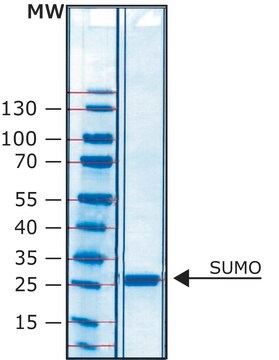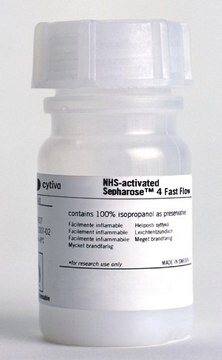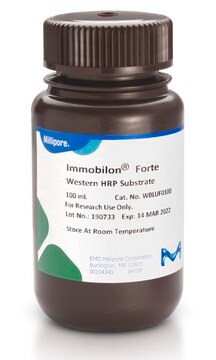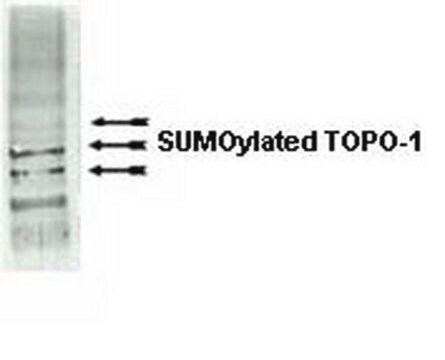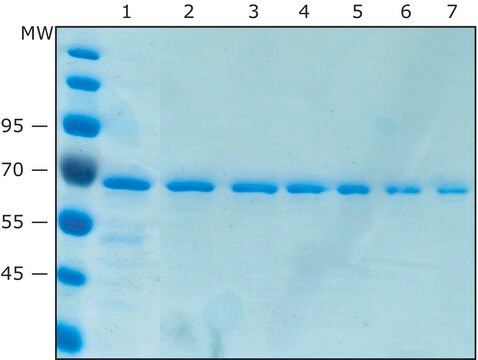推荐产品
生物源
mouse
品質等級
抗體表格
purified immunoglobulin
抗體產品種類
primary antibodies
無性繁殖
8A2, monoclonal
物種活性
human
包裝
antibody small pack of 25 μg
技術
immunocytochemistry: suitable
immunoprecipitation (IP): suitable
western blot: suitable
同型
IgG2bκ
NCBI登錄號
運輸包裝
ambient
目標翻譯後修改
unmodified
基因資訊
human ... SUMO2(6613)
一般說明
Small ubiquitin-related modifier 2 (UniProt P61956; also known as HSMT3, Sentrin-2, SMT3 homolog 2, Smt3B, SUMO-2, Ubiquitin-like protein SMT3B) and 3 (UniProt P55854; also known as SMT3 homolog 1, Smt3A, SUMO-3, Ubiquitin-like protein SMT3A) are encoded by the SUMO2 (also known as SMT3B, SMT3H2; Gene ID 6613) and SUMO3 (also known as SMT3A, SMT3H1; Gene ID 6612) genes in human. SUMOylation, protein post-translation modification by small ubiquitin-like modifier (SUMO), is a signaling event in many cellular processes. SUMO proteins are translated as immature precursors and subsequently converted to their mature forms through the activity of sentrin/SUMO-specific proteases (SENPs). SUMOylation is a reversible process. SUMO E1 activating enzyme, E2 conjugating enzyme, and E3 ligase mediate SUMOylation of substrate proteins, while SENPs are responsible for the de-SUMOylation. SUMOylation usually occurs at lysine residues in the consensus KxD/E motif, although not all such lysines become SUMOylated and SUMOylation can also occur on lysine residues outside of this motif. SUMO2 and 3 share 97% identity at the amino acid level, while SUMO1 shares only about 50% sequence homology with SUMO-2 and 3. In addition to difference in their target substrates, SUMO2/3 can be SUMOylated and form chains, whereas SUMO1 cannot and may serve as chain terminator. SUMO-2 can be covalently attached to proteins as a monomer or as a lysine-linked polymer. Its covalent attachment to its substrate via an isopeptide bond requires prior activation by the E1 complex SAE1-SAE2 and linkage to the E2 enzyme UBE2I, and can be promoted by an E3 ligase such as PIAS1-4, RANBP2, CBX4 or ZNF451. This post-translational modification on lysine residues of proteins plays a crucial role in a number of cellular processes such as nuclear transport, DNA replication and repair, mitosis and signal transduction. Although SUMO-2 functions in a manner similar to ubiquitin in that it is bound to target proteins as part of a post-translational modification system, however, unlike ubiquitin which targets proteins for degradation, SUMO-2 is involved in a variety of cellular processes, such as nuclear transport, transcriptional regulation, apoptosis, and protein stability. It is not active until the last two amino acids of the carboxy-terminus (aa 94-95; propeptide) have been cleaved off.
特異性
Clone 8A2 detects SUMO-2/3 in human cells.
免疫原
GST-tagged full length recombinant human SUMO-2 protein.
應用
Anti-SUMO-2/3, clone 8A2, Cat. No. MABS2039, is a mouse monoclonal antibody that detects SUMO-2 and SUMO-3 and has been tested for use in Immunocytochemistry, Immunoprecipitation, and Western Blotting.
Research Category
Signaling
Signaling
Western Blotting Analysis: A representative lot detected SUMO-2/3 in Western Blotting applications (Zhang, X.D., et. al. (2008). Mol Cell. 29(6):729-41; Zhu, S., et. al. (2009). Mol Cell. 33(5):570-80).
Immunoprecipitation Analysis: A representative lot detected SUMO-2/3 in Immunoprecipitation applications (Zhu, S., et. al. (2009). Mol Cell. 33(5):570-80).
Western Blotting Analysis: A 1:500 dilution from a representative lot detected SUMO-2/3 in HeLa cell lysate (Courtesy of Christine Lee, Matunis Lab, John Hopkins University, Baltimore, Maryland USA).
Immunocytochemistry Analysis: A 1:500 dilution from a representative lot detected SUMO-2/3 in HeLa cells (Courtesy of Christine Lee, Matunis Lab, John Hopkins University, Baltimore, Maryland USA).
Immunocytochemistry Analysis: A representative lot detected SUMO-2/3 in Immunocytochemistry applications (Zhang, X.D., et. al. (2008). Mol Cell. 29(6):729-41; Rao, H.B., et. al. (2017) Science. 355(6323):403-407).
Immunocytochemistry Analysis: A 1:500 dilution from a representative lot detected SUMO-2/3 in HeLa cells.
Immunoprecipitation Analysis: A representative lot detected SUMO-2/3 in Immunoprecipitation applications (Zhu, S., et. al. (2009). Mol Cell. 33(5):570-80).
Western Blotting Analysis: A 1:500 dilution from a representative lot detected SUMO-2/3 in HeLa cell lysate (Courtesy of Christine Lee, Matunis Lab, John Hopkins University, Baltimore, Maryland USA).
Immunocytochemistry Analysis: A 1:500 dilution from a representative lot detected SUMO-2/3 in HeLa cells (Courtesy of Christine Lee, Matunis Lab, John Hopkins University, Baltimore, Maryland USA).
Immunocytochemistry Analysis: A representative lot detected SUMO-2/3 in Immunocytochemistry applications (Zhang, X.D., et. al. (2008). Mol Cell. 29(6):729-41; Rao, H.B., et. al. (2017) Science. 355(6323):403-407).
Immunocytochemistry Analysis: A 1:500 dilution from a representative lot detected SUMO-2/3 in HeLa cells.
品質
Evaluated by Western Blotting in HeLa cell lysate.
Western Blotting Analysis: 4 µg/mL of this antibody detected SUMO-2/3 in HeLa cell lysate.
Western Blotting Analysis: 4 µg/mL of this antibody detected SUMO-2/3 in HeLa cell lysate.
標靶描述
~19 kDa observed; 10.87 kDa calculated. Uncharacterized bands may be observed in some lysate(s).
外觀
Protein G purified
Format: Purified
Purified mouse monoclonal antibody IgG2b in buffer containing 0.1 M Tris-Glycine (pH 7.4), 150 mM NaCl with 0.05% sodium azide.
儲存和穩定性
Stable for 1 year at 2-8°C from date of receipt.
其他說明
Concentration: Please refer to lot specific datasheet.
免責聲明
Unless otherwise stated in our catalog or other company documentation accompanying the product(s), our products are intended for research use only and are not to be used for any other purpose, which includes but is not limited to, unauthorized commercial uses, in vitro diagnostic uses, ex vivo or in vivo therapeutic uses or any type of consumption or application to humans or animals.
未找到合适的产品?
试试我们的产品选型工具.
我们的科学家团队拥有各种研究领域经验,包括生命科学、材料科学、化学合成、色谱、分析及许多其他领域.
联系技术服务部门
